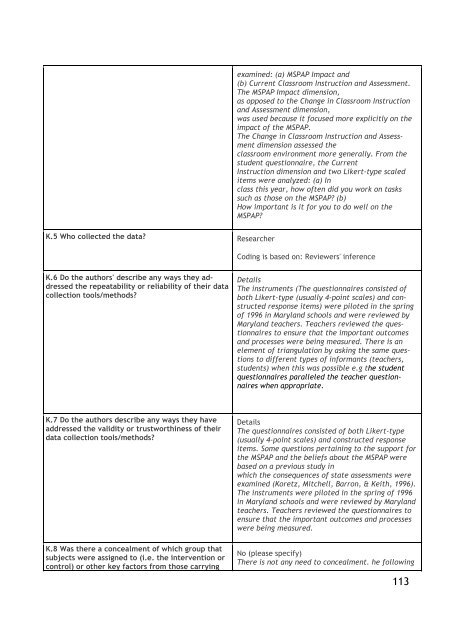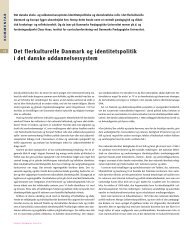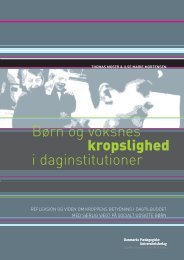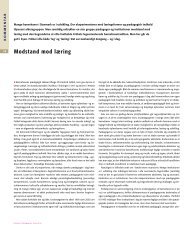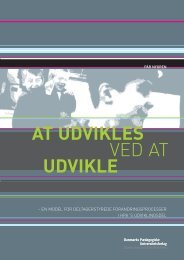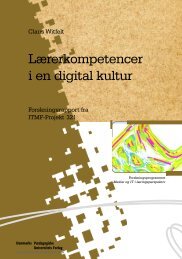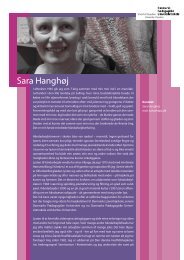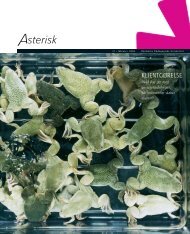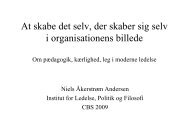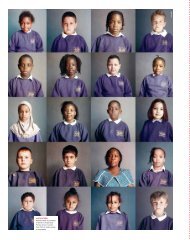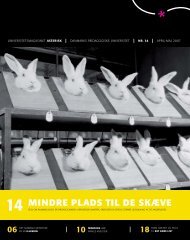SRI-Teknisk rapport-sen.v13 - DPU
SRI-Teknisk rapport-sen.v13 - DPU
SRI-Teknisk rapport-sen.v13 - DPU
Create successful ePaper yourself
Turn your PDF publications into a flip-book with our unique Google optimized e-Paper software.
K.5 Who collected the data? Researcher<br />
K.6 Do the authors' describe any ways they addressed<br />
the repeatability or reliability of their data<br />
collection tools/methods?<br />
K.7 Do the authors describe any ways they have<br />
addressed the validity or trustworthiness of their<br />
data collection tools/methods?<br />
K.8 Was there a concealment of which group that<br />
subjects were assigned to (i.e. the intervention or<br />
control) or other key factors from those carrying<br />
examined: (a) MSPAP Impact and<br />
(b) Current Classroom Instruction and Assessment.<br />
The MSPAP Impact dimension,<br />
as opposed to the Change in Classroom Instruction<br />
and Assessment dimension,<br />
was used because it focused more explicitly on the<br />
impact of the MSPAP.<br />
The Change in Classroom Instruction and Assessment<br />
dimension assessed the<br />
classroom environment more generally. From the<br />
student questionnaire, the Current<br />
Instruction dimension and two Likert-type scaled<br />
items were analyzed: (a) In<br />
class this year, how often did you work on tasks<br />
such as those on the MSPAP? (b)<br />
How important is it for you to do well on the<br />
MSPAP?<br />
Coding is based on: Reviewers' inference<br />
Details<br />
The instruments (The questionnaires consisted of<br />
both Likert-type (usually 4-point scales) and constructed<br />
response items) were piloted in the spring<br />
of 1996 in Maryland schools and were reviewed by<br />
Maryland teachers. Teachers reviewed the questionnaires<br />
to ensure that the important outcomes<br />
and processes were being measured. There is an<br />
element of triangulation by asking the same questions<br />
to different types of informants (teachers,<br />
students) when this was possible e.g the student<br />
questionnaires paralleled the teacher questionnaires<br />
when appropriate.<br />
Details<br />
The questionnaires consisted of both Likert-type<br />
(usually 4-point scales) and constructed response<br />
items. Some questions pertaining to the support for<br />
the MSPAP and the beliefs about the MSPAP were<br />
based on a previous study in<br />
which the consequences of state assessments were<br />
examined (Koretz, Mitchell, Barron, & Keith, 1996).<br />
The instruments were piloted in the spring of 1996<br />
in Maryland schools and were reviewed by Maryland<br />
teachers. Teachers reviewed the questionnaires to<br />
ensure that the important outcomes and processes<br />
were being measured.<br />
No (please specify)<br />
There is not any need to concealment. he following<br />
113


